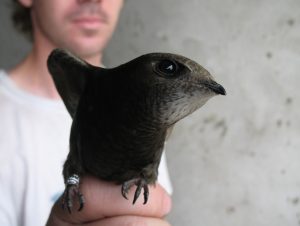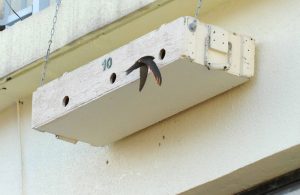The Swifts
The swifts are a family, Apodidae, of highly aerial birds. They are superficially similar to swallows, but are not closely related to any passerine species. Swifts are placed in the order Apodiformes with hummingbirds. The treeswifts are closely related to the true swifts, but form a separate family, the Hemiprocnidae. [Wikipedia]
The Swifts (aka “The Swifts of the Walls” or “The Swifts of the Cities”) are a special migratory birds, whose number in the world is dwindling.

Characteristics:
- The Swift is constantly in aviation and does not land at all, except for nesting purposes and raising offspring.
- The Swift is among the fastest birds in the wild. It can reach about 70 meters / second (220 km / h!) in a straight flight, during games and group juggling maneuvers used to strengthen social connections, to smuggle competitors from the nesting grounds and to avoid predators.
- The Swift is a small bird in size and weigh about 35-55 gr.
- Their color is black-brown and with a whitish stain on their chin (that is larger among younger swifts).
- There are no color differences between males and females and the only sign by which the gender can be distinguished is in their wheezing / chirping sounds, as the females’ tweet tone is higher than that of the males.
- The relationship between the Swift couple is permanent and lasts for many years.
- The swifts live a long life, it is known to those who have reached the age of 21 years.

The swifts migrate north from the African continent after the peak of our winter passes, arriving at us around February the 20th, before the official beginning of the spring.
Ali Mohr (RIP), who admired the swifts, wrote: “Swallows do not herald the coming of spring, one swift does.”
They will arrive to Europe only in early May.
The swifts stay here only about 100 days, and then return south to Africa just days after the first lift-off of their offspring.
The swifts always live in groups. During the nesting period, they will always return to their permanent compound area, known as the colony, with each pair returning exactly to the same nest they nested in the previous season.
They rarely fly alone and mostly see them maneuver in groups and marvel at their breathtaking stunts.
The groups do not arrive at once, there are 4 waves of arrival:
The first group is a small group of nesting birds, which probably serve as a scout. These may be young individuals who are breeding and are therefore have a higher physical capabilities.
About a week later, another group of nesting swifts will arrive.
A few days later the main group of nesting swifts will arrive.
A month later, the last group consisting of older non-productive swifts and young ones who have not yet reached sexual maturity arrive. Together, they will help preserve the colony’s site by having their regular presence in the area of the compound in the morning and before sunset as the youngsters look for future nesting sites for when they reach sexual maturity.
Prior to nesting, the spouse’s search and courting period begins.
The courtship can be seen as the bird stops its wings for a brief second and raises them up and flies motionless with its wings tilted upwards in the V-shaped as a butterfly.
The adult couples, who know each other, will mate soon strongly basing their nest and will visit it, each on his turn, even during the day, before laying eggs and incubating.
After mating, 2 – 3 eggs will be laid and incubation (for about 20 days) begins with full partnership.
The duration of chicks breeding until they fly out of the nest is relatively long and will last about 40 days. During this time, parents descend from heights to feed their offspring every hour.
The baby swifts that take off their first flight from the nest where they are born will not stop flying from this moment and will remain in the air for 3-4 consecutive years until they reach sexual maturity.
The swifts are special in their unrelenting fidelity to the nesting place. They will always prefer to return back the nest they know, or compromise to the closest environment they can remember in case the nest is destroyed.
During their three-month stay, they will always fly around the colony compound, except when the weather turns stormy, then they move away from the area and return immediately as the storm passes.
In case of turbulent weather during the incubation or breeding period, the swifts are able to enter a “torpor” state – slowing metabolism to the minimum required to survive and stay alive; kind of a “winter sleep”.
One of the oldest colonies in the world is in the Western Wall, among its slots. The last surveillance and mapping of the nests conducted in 2002 by researcher Ulrich Tiggs from Germany, found that it has 88 nests!
During their stay with us, we can see them for two periods during the day:
The first period will occur from sunrise until about two hours later and we can spot them flying in groups around the colony as they marvel with their stunts and make their voices heard, then ascend to a high altitude of 3,000 meters and disappear from our eyes.
The second period is about an hour and a half before sunset. The swifts will go down and fly around the nest area and return beautifully to their amazing maneuverability while playing their typical blustery tweets until sunset time.
At nightfall, they will split into two groups: the group of non-nesting swifts (the older and younger), will rise back up to a night sleep on the waves of warm air arising from the city centers.
The second group, the breeders, will enter their nests in the colony compound and spend the night there, the couple together and their chicks, if they have already hatched.
The swifts nourish on small insects that they hunt in the air, especially mites and little spiders migrating in the spring and are abundant.
Therefore, their beak shape is short and wide, triangular, but the mouth gap is large and adapted to capture insects when flying with open mouth.
During offspring raising period, the swift will hunt around 20,000 mite in one day to feed its offspring in the nest.
The parent swift does not swallow the mites, but collects them in its mouth with special saliva (also used as a glue when building the nest) into a small olive-size ball called “bolus”, which will later infiltrate to the throats of its offspring.
Swift researcher, Yaron Bayser, reported he witnessed the feeding of about 3 cm bolus.
The process of collecting insects is very beneficial to us since it reduces the number of insects that are a nuisance and even cause damage.
The construction momentum occurring through the populated centers in Israel and around the world has seriously damaged the swifts’ nests and, with the lack of nesting places, their number is declining drastically.
In most European countries, this bird was declared protected and environmental organizations began rehabilitating its nesting options with the aim of preserving and preserving this wonderful bird.
Up till now, over 100 nesting cells have been carried out throughout Givatayim and Tel Aviv-Jaffa.
Cities like Zurich, Basel, Amsterdam, Sussex and Edinburgh, joined the limited global group of environmentally friendly cities in which they initiate to returning the nesting of the swifts, thus ensuring their future.
